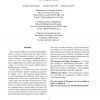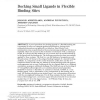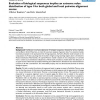100 search results - page 20 / 20 » Structure From Motion Using Sequential Monte Carlo Methods |
NIPS
2003
13 years 6 months ago
2003
In typical classification tasks, we seek a function which assigns a label to a single object. Kernel-based approaches, such as support vector machines (SVMs), which maximize the ...
CGI
1998
IEEE
13 years 9 months ago
1998
IEEE
Ray tracing and Monte-Carlo based global illumination, as well as radiosity and other finite-element based global illumination methods, all require repeated evaluation of quantita...
JCC
1998
13 years 5 months ago
1998
: A novel procedure for docking ligands in a flexible binding site is presented. It relies on conjugate gradient minimization, during which nonbonded interactions are gradually swi...
SADM
2010
13 years 3 days ago
2010
: The k nearest neighbor classification (k-NN) is a very simple and popular method for classification. However, it suffers from a major drawback, it assumes constant local class po...
BMCBI
2008
13 years 5 months ago
2008
Background: Confidence in pairwise alignments of biological sequences, obtained by various methods such as Blast or Smith-Waterman, is critical for automatic analyses of genomic d...



